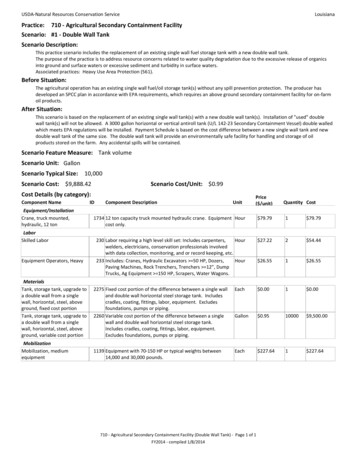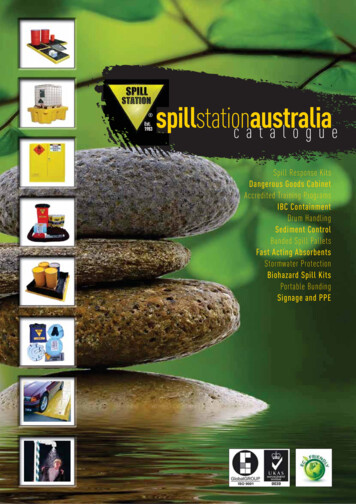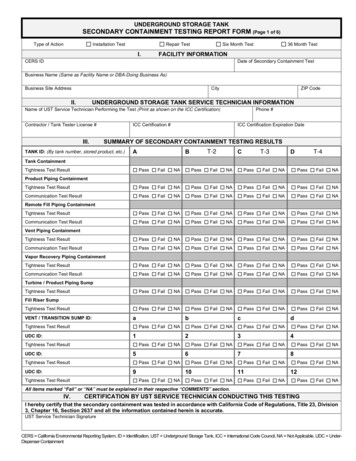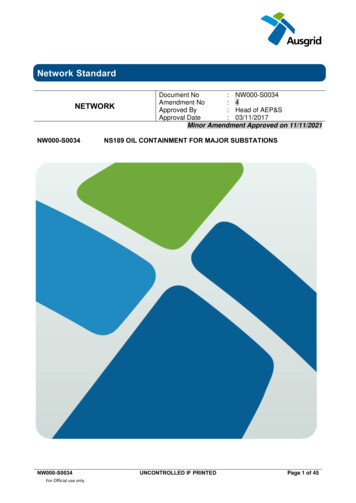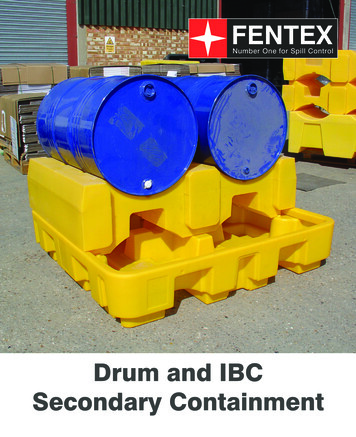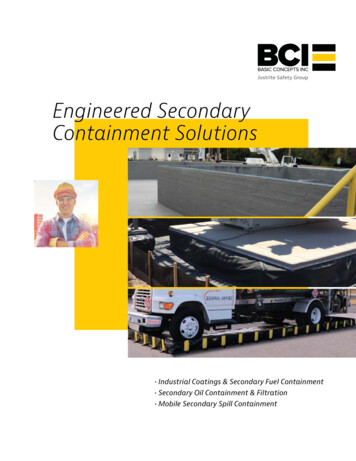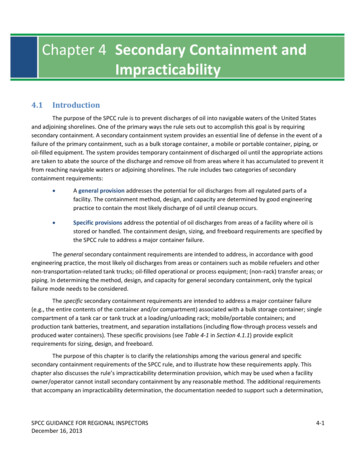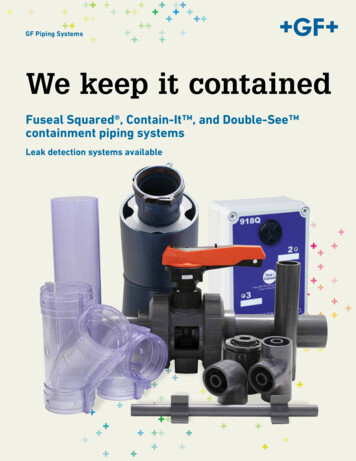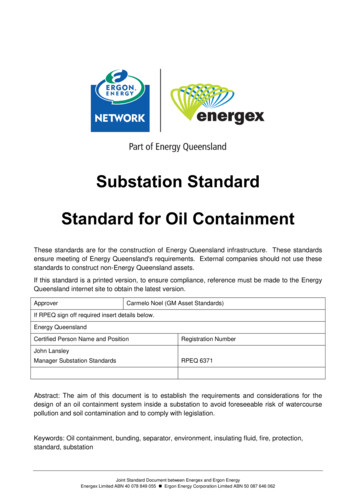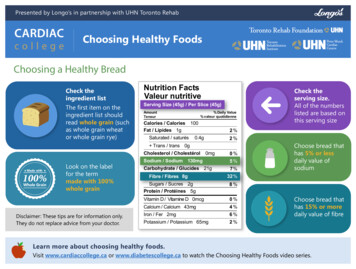
Transcription
Karen D. HamelTechnical Education ManagerNew Pig CorporationOne Pork AvenueTipton, PA 16684(800) HOT-HOGS www.newpig.comSecondary Containment Systems:Choosing a Containment Pallet or DeckMarch 2011
SummarySecondary containment devices provide a back-up system to prevent the release of a spillin the event that a primary container fails.Custom-made secondary containment products – usually consisting of an imperviousconcrete pad and curbing – are commonly designed by engineering firms and helpfacilities comply with regulations. But, with the hundreds of pre-fabricated containmentoptions available today, there’s a ready-made solution for almost every need. Prefabricated systems save time and money. They can also be relocated as needs orprocesses change.Traditionally, secondary containment systems were designed for compliance with theEnvironmental Protection Agency’s (EPAs) hazardous waste storage regulation, 40 CFR264.175. However, more recent regulations, such as EPA’s Spill Prevention Controland Countermeasures (SPCC) rule also require active and / or passive containment.Providing containment can also be considered a Best Management Practice (BMP) forEPA’s Stormwater regulations.Depending on the materials stored, fire codes can also play a role in containmentrequirements, as does the location of containment system. Storing flammable liquidsoutdoors, for example, is more involved than storing them inside.Being aware of regulations and applying knowledge of the liquids being contained arekey steps in choosing a pre-fabricated containment system that will meet a variety ofneeds, and be versatile enough to grow and change with the facility. Engineered secondary containment systems are costly and hard to adapt as facilityneeds changePre-fabricated containment systems are less expensive but just as effective asengineered systemsBeing aware of regulations will help ensure that the proper containment productsare purchased
Regulatory ConsiderationsFederal EPA secondary containment regulations (40 CFR 264.175) apply to hazardouswaste generators. To meet this regulation, containment systems must meet thefollowing specifications: The base must be free of cracks or gaps and must be sufficiently impervious tocontain leaks, spills, and accumulated precipitation (264.175(b)(1)). The base must be sloped or the system must be designed so that spilled liquidscan be removed. This is not necessary, however, if the container is elevated (e.g.,on pallets) or otherwise protected from contacting accumulated liquids(264.175(b)(2)). The secondary containment system must have the capacity to contain at least 10percent of the total volume of the containers or 100 percent of the volume of thelargest container, whichever is greater. (264.175(b)(3)). Stormwater run-on must be prevented from entering the system unless thecollection system has sufficient capacity to contain any run-on entering thesystem in addition to the capacity requirements (264.175(b)(4)).Containment is also a key provision in the EPA’s SPCC rule. (40 CFR 112) In aguidance document, the EPA states, “Secondary containment systems provide anessential line of defense in the event of a failure of an oil container.” Two forms ofcontainment are outlined: General secondary containment requirements address the most likely oildischarge from bulk storage containers; mobile/portable containers; productiontank battery, treatment, and separation installations; a particular piece of oil-filledoperational or process equipment; (non-rack) transfer activity; or piping inaccordance with good engineering practice. Specific secondary containment requirements are intended to address a majorcontainer failure (the entire contents of the container and/or compartment)associated with a bulk storage container; single compartment of a tank car or tanktruck at a loading/unloading rack; mobile/portable containers; and production tankbatteries, treatment, and separation installations.The rule also specifies procedures for active and passive containment. Activecontainment measures are those that require deployment or other specific action by theowner or operator. Passive measures do not require deployment or action by theowner/operator.A goal of EPA’s Stormwater Regulation is to prevent “illicit discharges,” which arebroadly defined as any discharges into a storm drain system this are not composedentirely of stormwater. The regulation calls upon facilities to use proactive “BestManagement Practices” (BMPs) to prevent discharges. Properly maintained containmentsystems can be considered BMPs because they capture liquids at the source of the spill,preventing discharges.
Too often, a spill containment system is designed and installed to satisfy an isolated need:compliance with a specific state or local environmental regulation, to meet a specificobjective, or maybe the desire to eliminate the slippery floor around waste collectioncontainers. Unfortunately, engineered systems are hard to adapt if processes or thefacility layout changes, or if additional needs are uncovered later.Pre-fabricated containment devices help to satisfy a number of different environmental,health and safety requirements, and can help lower insurance premiums. Because theyare not “built in,” they can be moved or relocated as processes or needs change withoutextensive deconstruction and reconstruction time and costs.The wide variety of pre-fabricated containment pallets and spill decks available meansthat, for most facilities, the products needed for compliance are not more than a phonecall away. Considering the following factors will aid in selection of a system to bestmeet facility needs.Containment Pallet or Spill Deck?Containment Pallets are stand-alone sumps capable of supporting one to eight 55-gallondrums, and have the ability to retain the entire contents of a 55-gallon drum should theprimary container fail. Spill Pallets are typically preferred when: The number of containers storedper unit is limited to 8 or lessRegulations require the sump tohold 100% (or more) of thelargest container storedStorage space is limitedThe unit does not need to beportableThe containers are notloaded/unloaded frequentlyThe unit is not being used forfluid dispensing or wastecollectionModular Spill Decks are inter-connectible sumps capable of individually supporting oneto four 55-gallon drums. These units have the ability to be linked physically andhydraulically to provide spill containment for multitude 55-gallon drums. They can also
be used independently to capture nuisance leaks and spills, if full containment is notdesired or necessary. Modular Spill Decks are typically preferred when: Space is available for linking multiple unitstogether to achieve regulation-requiredsump capacityThe number of containers stored is 8 ormoreThe unit does not need to be portableLow-profile is desired for drum-topaccessibility or frequent loading/unloadingThe unit is used for fluid dispensing and /orwaste collectionA single device is used for "housekeeping"purposes rather than “containment”Bladder Decks, while similar in design to Modular Spill Decks, bladder decks feature aunique concealed bladder that deploys only in the event of a leak that would overflow theDeck. Bladder Containment Decks are typically preferred when: Containment is required for one to fourcontainersFloor space is limited, yet space aislespace is available for the bladder todeploy when neededLow-profile is desired for drum-topaccessibility or frequentloading/unloadingPolyethylene, Fluorinated Polyethylene or Steel?Chemical resistance of polyethylene or steel is often the primary factor when choosingthe materials for a containment device. Fluorinated polyethylene, with its increasedchemical resistance, offers another choice when handling chlorinated solvents or otherliquids that degrade regular polyethylene.
Polyethylene is typically preferred when: Corrosive or reactive chemicals are storedTemperature extremes are not involvedCorrosion of steel in high-humidity/corrosiveenvironments is a factorDedicated bonding/grounding points are notrequiredCost is a primary concern Fluorinated polyethylene is typically preferred when: Polyethylene-degrading liquids are storedTemperature extremes are not involvedDedicated bonding/grounding points are notrequiredCost of steel is a concernSteel is typically preferred when: Solvents, fuels, and polyethylenedegrading liquids are storedTemperatures extremes are involvedHigh-humidity/corrosive environments arenot a factorBonding/grounding points are requiredAbility to resist damage from repeatedforklift handling is a concern
Storing flammables or combustibles?Flammable liquid storage and handling is a highly-regulated subject, yet there is littleguidance offered by OSHA, the NFPA, or the Uniform Fire Code on the subject of using,or not using, polyethylene spill containment devices when storing flammables andcombustibles.When polyethylene or fluorinated polyethylene is compatible with a flammable orcombustible liquid, consider these factors when determining if a steel containment unit isneeded: Fire- or heat-resistance of thecontainment device,Control of staticaccumulation/discharge throughbonding and grounding,Proximity of the containmentdevice to heat or ignition sourceswithin the facility,OSHA regulations as well as localfire codes regarding collection andstorage of flammables,Property insurer requirementsregarding storage of flammableliquids.If the containment system will be used as a fluid dispensing or waste collection stationfor flammable materials, OSHA requires bonding and grounding of the containers whenfluids are being transferred. This cannot be accomplished with a polyethylene unit.When in doubt, contact a local OSHA office, fire marshal, or "authority havingjurisdiction" over fire codes in the locality.Flammable liquids that are to be stored outdoors have many additional requirements thatvary greatly from state to state. Reputable suppliers can help guide facilities through theprocess of obtaining a building or structure that meets state and local safety codes.Stationary or Mobile?Consider the current and future physical requirements of spill containment devices whenchoosing between a pallet and deck.
Will the containment area needed to be expanded or reconfigured in the future?Will the containment units need to be moved while the containers are on them?Is drum-top height at waste collection stations a concern?Will high-specific gravity liquids be stored on the pallets?Modular Spill Decks feature inter-connectable bulkheads that allow multiple units to beconnected on all four sides. These ports may be linked or closed as future needs require.The low profile also allows easier drum loading/unloading along with convenient accessto drum tops.Spill Pallets are recommended for a fixed installation of a small number of drums. If thespill pallet must be moved while the containers are fully loaded, carefully consider thedesign of the spill pallet and how the weight will be supported during the move,especially if the unit is not made of steel. For polyethylene pallets:Choose low-cost, low weight rating pallets when: The unit will not be moved while loaded Liquids do not have a high specific gravity Liquids are stored in steel drumsChoose heavy-duty pallets when: The pallet could need to be moved while loaded Liquids on the pallet have a high specific gravity, such as acids or caustics Liquids are stored in plastic drums Various sized containers are being storedWhen the spill pallet must be mobile or hold high-load forces, the slightly increased costof a heavy-duty spill pallet will prove to be a worthy investment.For facilities that have stock levels that vary,collapsible containment systems may be the answer.These systems are capable of holding anywhere fromone drum to several totes of product. They can be usedindoors or out, and fold compactly when not in use.
Security or Protection from the Elements in Outdoor Use?When drums must be stored outdoors on a spill containment device, security of thecontainers and to the prevention of water accumulation in the sump are two factors toconsider. In addition, the means of protection must not interfere with access to thecontainers for visual inspections and should not hamper the workers who will access thedrums for pumping or waste collection purposes.Several types of products are available to cover containers and protect the sumps fromprecipitation. These products include: Tarps with elasticized bottoms and grommets- Low cost. Good for storage when containers are not accessed frequently Hard plastic covers hinged to swing upward- Good when containers are rotated more frequently, but not when thestation is used for pumping or waste collection Complete plastic enclosures with doors and roll-up upper panels- Ideal for storage of containers that are frequently rotated, or for pumpingand waste fluid collection stationsToday's modern spill containment devices offer a range of uses and flexibility which canbe tailored to suit virtually any need, indoors or outdoors. Careful planning prior tomaking a selection will help ensure that the containment device provides years ofprotection of the environment and efficient, convenient service for your employees.
Containment is also a key provision in the EPA's SPCC rule. (40 CFR 112) In a guidance document, the EPA states, "Secondary containment systems provide an essential line of defense in the event of a failure of an oil container." Two forms of containment are outlined: General secondary containment requirements address the most likely oil
